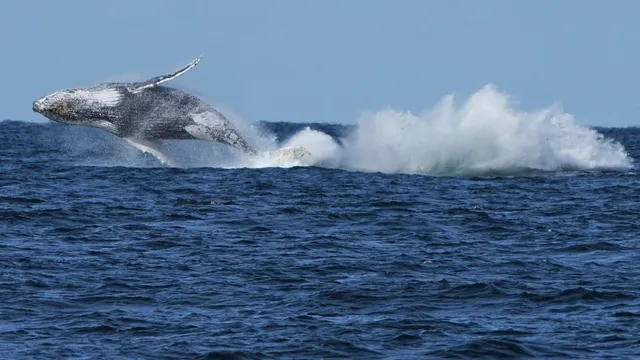
Humpback whales surge in population, disrupting Sydney water traffic
2025-06-26 07:48- In winter, humpback whales migrate along Australia's east coast, often halting water traffic in Sydney.
- The population of humpback whales has rebounded to about 40,000 since being protected in 1963.
- Increasing human-whale interactions raise concerns about safety and conservation efforts.
Express your sentiment!
Insights
Australia is currently witnessing a remarkable phenomenon where Sydney's harbor serves as a migration route for humpback whales, as they journey from their feeding grounds in Antarctica to breeding areas off the Queensland coast. This migration occurs during winter, particularly in June and July, when it is common for these majestic creatures to come into close proximity with urban life, sometimes halting water traffic due to their sheer size and curiosity. Humpback whales, which can reach lengths of 16-17 meters and weigh up to 40 tonnes, are often spotted by residents of Sydney as they engage in incredible aerial displays. This close interaction is unprecedented, as fewer than a thousand whales existed before they were declared a protected species in 1963. Today, their numbers have rebounded dramatically to about 40,000, which has resulted in increased encounters with boats and fishing nets. Local wildlife scientists, such as Dr. Vanessa Pirotta from Macquarie University, are studying this unprecedented return of humpbacks to the area. They note that these whales are incredibly curious animals, often found breaching the surface in urban settings where people can easily observe them during routine activities, such as morning walks or coffee runs. Sightings of famous individual whales, like Migaloo, the all-white humpback, have also become a part of the local culture. However, this increased visibility and interaction with humans bring challenges. As their population grows, concerns are rising regarding entanglements with fishing gear and potential collisions with vessels. Additionally, changing environmental factors, such as overfishing of krill and the effects of climate change, could be influencing their migratory patterns. This situation presents both opportunities for public engagement in whale conservation as well as the need for thoughtful measures to coexist with these giants of the sea.
Contexts
The conservation of whale populations is critical for maintaining marine biodiversity and ensuring ecological balance in oceanic environments. Whales play a vital role in the marine ecosystem by influencing the population dynamics of prey species and helping to regulate oceanic nutrient cycles. However, human activities pose significant threats to these majestic creatures. Detrimental factors include commercial whaling, habitat loss, climate change, and pollution. Consequently, it is essential to adopt and promote sustainable practices aimed at protecting whale populations to ensure their survival for future generations. One of the foremost strategies in promoting sustainable practices is the enforcement of marine protected areas (MPAs). MPAs serve as safe havens for whales and other marine fauna, allowing populations to recover from past exploitation and threats. The establishment of these zones restricts harmful activities such as commercial fishing and shipping lanes that can lead to entanglements and ship strikes. Likewise, international collaboration is necessary, as whales often traverse vast oceanic regions that extend across national borders. By engaging in multinational agreements and following the guidelines established by organizations like the International Whaling Commission, nations can work together to protect migratory patterns and breeding grounds. In addition to MPA implementation, it is vital to promote sustainable fishing practices. Overfishing depletes whale prey populations and can lead to unintended bycatch, where whales become entangled in fishing gear. By advocating for responsible fishing regulations, such as catch limits and seasonal closures, we can mitigate these threats. Furthermore, promoting the use of whale-safe gear can significantly reduce the risk of entanglements, hence improving the survival prospects for numerous species of whales. Public awareness campaigns can also educate fishing communities about the importance of whales in marine ecosystems, fostering a more conservation-minded approach to fishing practices. Lastly, addressing the impacts of climate change through carbon footprint reduction and sustainable development will positively influence whale habitats. Climate change leads to ocean acidification and altered prey distributions, which can adversely affect whale populations. Efforts to combat climate change include transitioning to renewable energy sources, reducing plastic pollution, and advocating for sustainable land-use practices. By implementing these strategies, we can create a healthier, more resilient marine environment conducive to the survival and flourishing of whale populations. Protecting whales is not only crucial for their own survival but also for the health of our oceans and the planet.